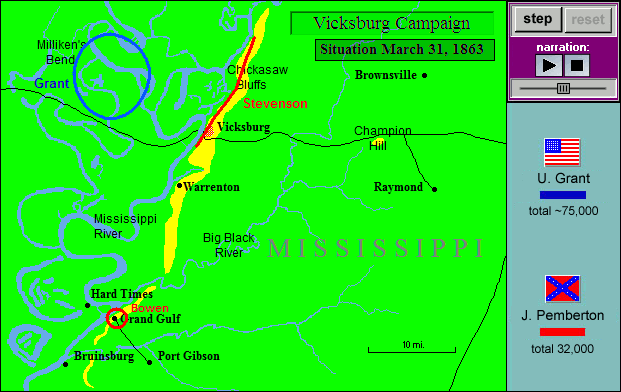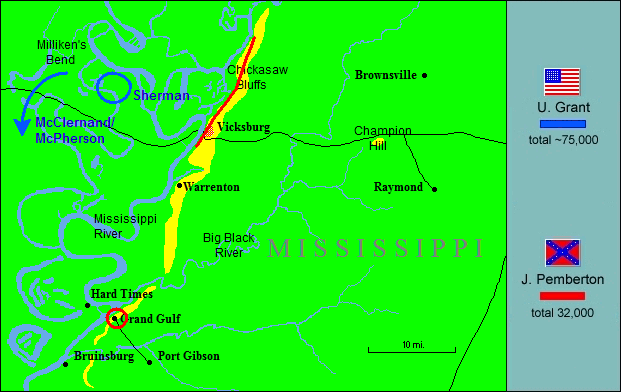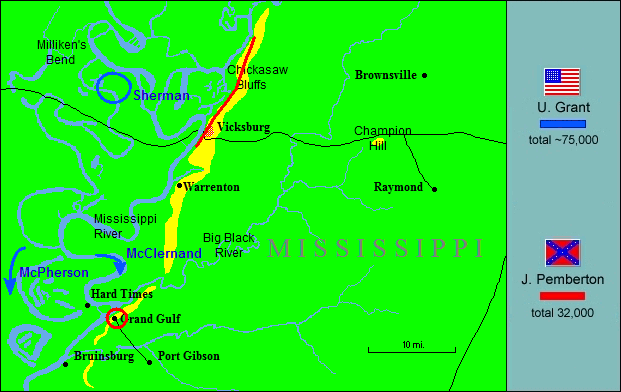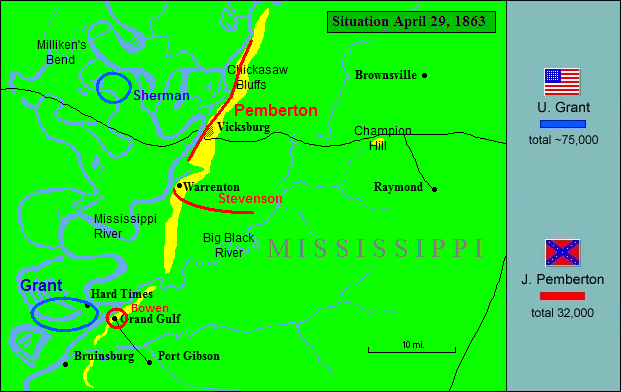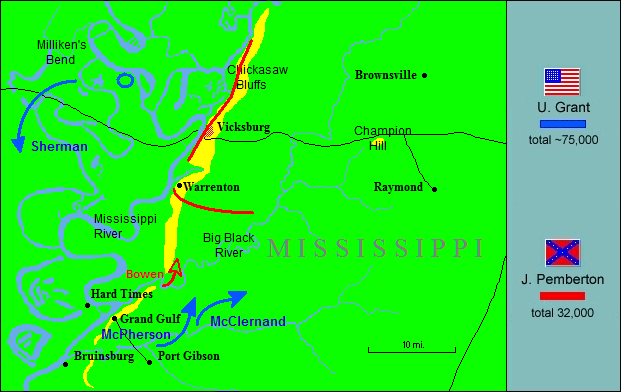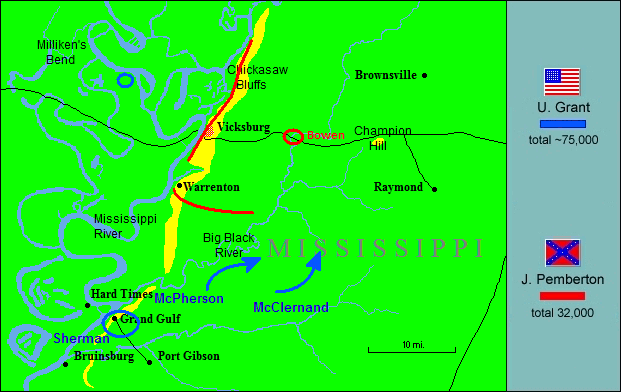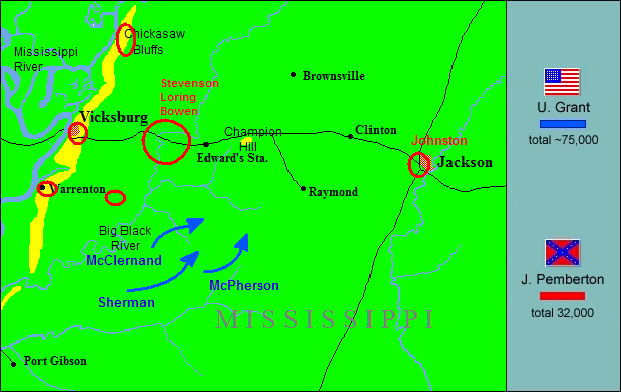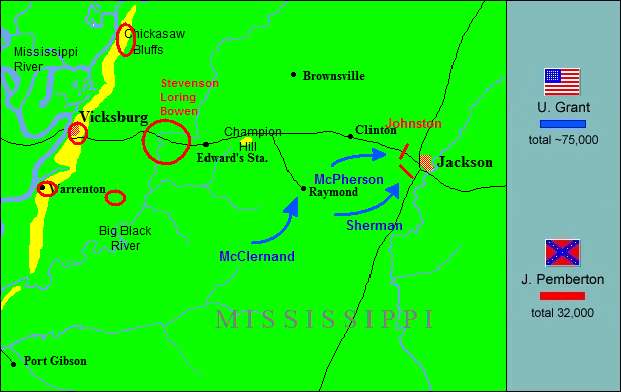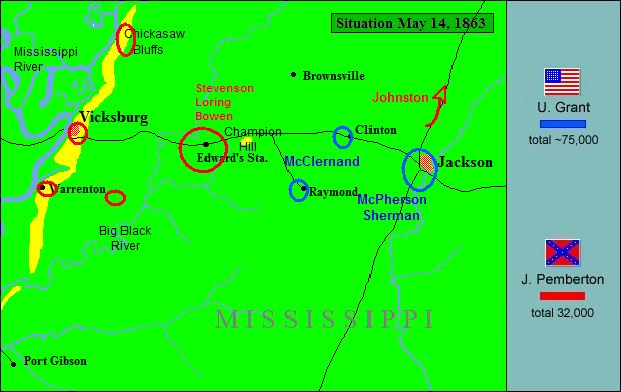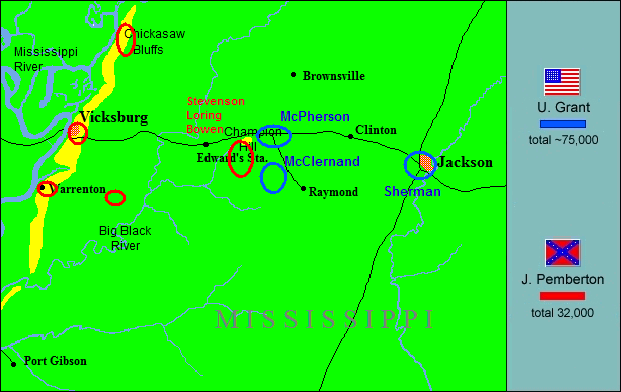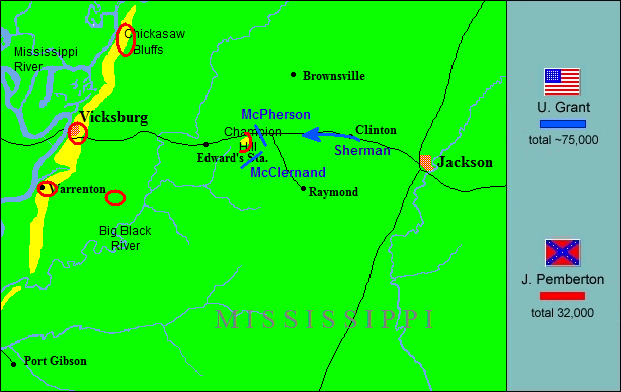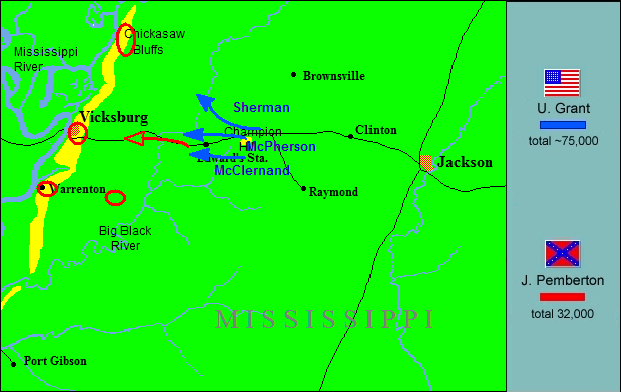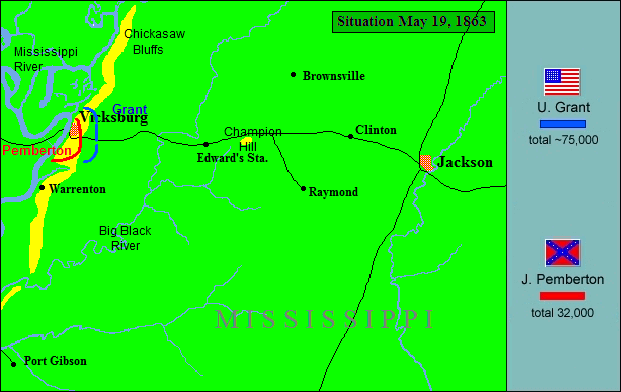Vicksburg is the key. The war can never be
brought to a close until the key is in our pocket.
–Abraham Lincoln
Of the three Federal offensives of the winter of 1862, two had come to naught before the new year was two days old. Ambrose Burnside had smashed up on the stone wall at Fredericksburg and William Rosecrans had fought to a bloody stalemate at Stones River. Those two battles had cost more than 25,000 Union casualties. The third offensive, against Vicksburg on the Mississippi, promised the most significant strategic success. In November of 1862, however, success on the Mississippi seemed very long odds.
At that time the Confederacy controlled just 250 miles of the river, from Vicksburg, Mississippi, south to Port Hudson, Louisiana. At Vicksburg, however, the Confederacy had what looked to be an impregnable citadel. This prosperous city of 4,500 stood on high ground on the river’s east bank. Vicksburg’s powerful batteries, well-fortified on steep bluffs, made an approach from the river side unthinkable. Just to the north, the Yazoo River flowed into the Mississippi, and the bluffs on its south bank made an approach from that direction a tough proposition also. An approach from the swampy Louisiana shore south of the city was possible, but then there was no way to cross to the Vicksburg side without steamboats, and it seemed unlikely that those boats could safely steam past Vicksburg. The only approach to Vicksburg that promised to pay was from the east, but getting an army there would prove a long and laborious business. When it got there, it would find, in the words of one Union officer who fought there, a “long line of high, rugged, irregular bluffs, clearly cut against the sky, crowned with cannon which peered ominously from embrasures to the right and left as far as the eye could see… The approaches to this position were frightful.”
The business of breaking into this fortress fell to Ulysses S. Grant, who, despite failure in the old army and in civilian life, maintained an unshakable self-confidence. One subordinate said he “habitually wears an expression as if he had determined to drive his head through a brick wall, and was about to do it.” In November he was top commander of all Federal forces in the West, operating out of Memphis with the Army of the Tennessee. Grant’s first idea in this complicated campaign was simple: he would establish a base of supplies at Holly Springs, just twenty-five miles into Mississippi, march his army down to Jackson following the railroad, then turn west to get at Vicksburg from the east.
Meanwhile, Sherman–Grant’s warhorse–would march his corps from Memphis down the east bank of the river and press the city from the north. Lieutenant General John C. Pemberton’s 30,000 Confederates could not block both advances at once. One or the other Federal advance, Grant believed, would break through. Grant, however, had not reckoned on Rebel cavalry on a rampage in his rear. (Not until the third summer of the war would Yankee cavalry really begin to fight on equal terms with the Rebels.) Earl Van Dorn, though whipped in Corinth back in October, still had plenty of fight left in him. His troopers rode down to Holly Springs, and suddenly Grant’s base of supply was first a Confederate commissary, then ashes. At the same time, Bedford Forrest was loose again in west Tennessee, tearing up railroads, tearing down telegraph lines, and helping himself to the riches of the Federal government. There was nothing for Grant to do but return to Memphis and see to the fire in his rear. (He had, by the way, a life-long superstitious dread of retracing his steps.) This move of course left Sherman dangling. With no way of knowing that Grant was out of the picture, Sherman on December 29 threw his corps against Pemberton’s garrison on Chickasaw Bluffs on the Yazoo River. He was repulsed in short order with 1,700 casualties. The first blow against Vicksburg was the merest tap at the gate.
What happened next provides an interesting sidebar on popular democracy at war. One John A. McClernand, an Illinois politician, like many another political general, had got a taste for military glory. His stature as a “War Democrat” gave him influence in Washington and won him a brigadier’s commission. He had in fact fought capably under Grant at Fort Donelson and Shiloh. Now a major general, he had permission from Lincoln and Halleck to raise volunteers in the Northwest and take them down the Mississippi to operate against Vicksburg. McClernand spoke confidently of “cutting [his] way to the sea” and winning glory, glory that–who could know–might put him in the White House one day. With his command, he joined Sherman on the river on January 2 (the same day Breckinridge’s attack at Stones River failed). Much to Sherman’s chagrin, McClernand, who ranked him, now took charge of the whole show. The new commander saw pretty clearly that it was going to be harder to win glory against Vicksburg than he supposed. He would instead, in cooperation with Admiral David Porter’s gunboats, steam up the Mississippi to the mouth of the Arkansas River and capture Confederate Fort Hindman at Arkansas Post forty miles upstream. In fact, the expedition was quite a crisply-run operation, and between the ironclads and the bluecoats, the 5,000 men of the garrison were, after a brief fight, prisoners of war on January 11. “Glorious! Glorious!” McClernand exulted, “My star is ever in the ascendant.” Grant, however, saw the expedition a good deal differently. To him, it was merely a “wild-goose chase to the Post of Arkansas,” accomplishing little that might contribute to the effort against Vicksburg. McClernand’s day of glory was brief, and he was ordered back to the river. By the end of the month, Grant had taken command on the west bank of the Mississippi with more than 40,000 men at Young’s Point and Milliken’s Bend, just upriver from Vicksburg.
The next phase of the campaign would involve a great deal more marching, steaming, chopping, ditching, and dredging than fighting. Indeed, Grant thought it might be possible to solve the initial Vicksburg problem–getting on dry ground east of the city–without a fight at all. Directly in front of Vicksburg, the river made a tight loop, creating a peninsula pointed at the city. If a canal could be dug across the base of this long finger of land, the batteries on Vicksburg’s bluffs were a moot point. Boat traffic would simply bypass the city. Sherman’s men went to work ditching and dredging and eventually cut a canal. But the big river, then as now, seemed to have a will of its own, and in the end not enough water flowed into the channel to carry shipping. Grant’s next thought was a roundabout route. Fifty miles upriver on the west bank was a broad backwater of the river known as Lake Providence. A network of streams flowed south from that body of water eventually emptying into the Red River. If Grant could open a channel from the river to the backwater, then dredge and deepen the streams that flowed south, his steamers might reach the Red River and follow it down to the Mississippi again 150 miles below Vicksburg. It was a long way ’round, to be sure, but the route would put him at last on the east bank south of Vicksburg. There was a catch of course, and after two months of labor Grant could see that he could never dredge those streams deep enough.
Grant’s next effort took him even farther from Vicksburg. More than three hundred miles upriver was a deep bayou east of the river known as Yazoo Pass. It was now cut off from the river by a stout levee that kept the river from flooding cottonfields with every rise. Before the levee had been built, though, shipping had steamed from the river east across Yazoo Pass into the Coldwater River. That river in turn flowed south into the Tallahatchie. Where the Yalobusha joined the Tallahatchie a little farther down, the Yazoo River was formed, and the Yazoo of course flowed into the Mississippi just above Vicksburg. It was a tortuous enough route, but it could put Grant’s army on the south bank of the Yazoo in position to take in flank those fortified bluffs that had turned back Sherman’s frontal assault so easily in December. The levee was mined and blown in a perfectly wonderful explosion. With Yazoo Pass open, a small Federal flotilla steamed across it to the Coldwater regardless of obstacles. It got as far as the confluence of the Tallahatchie and the Yalobusha, and there ran into Fort Pemberton. This fort was neither particularly strong nor well-armed, but the approach to it was a narrow, straight stretch of river. Moreover, it was commanded by Brigadier General Lloyd Tilghman, who had already surrendered once to Grant, at Fort Henry on the Tennessee, and did not mean to yield a second. The Federal gunboats made two efforts, and, with no room to maneuver and exert their collective firepower, were pounded and driven back the way they came.
Grant was going to make one more effort to conquer the geography of the upper Mississippi Valley. The plan was Porter’s, and it was another complicated design to get on the south bank of the Yazoo. Five miles above its mouth, the waters of Steele Bayou flowed into the Yazoo. Forty miles up the bayou, it connected eastward to Deer Creek, and Deer Creek in turn connected eastward to the Sunflower River. The Sunflower flowed south into the Yazoo–above the fortified bluffs north of Vicksburg and far below Fort Pemberton. Porter convinced Grant that, with the levee at Yazoo Pass gone, the water would be deep enough to navigate gunboats and transports up the bayou, over the creek, and back down the Sunflower into the Yazoo. Sherman’s men put down their picks and shovels, took up their rifles, and slogged for the transports. With the gunboats ahead they all commenced to steam slowly into a sailor’s nightmare. The creeks and bayous were narrow–barely the width of a boat–twisted, and choked with willow. Confederates felled trees to bar the way. When the boats steamed into and under trees, sailors and soldiers got an unpleasant shower of rats, raccoons, snakes, even panthers from the limbs above. In the end, Porter’s gunboats finally just stuck in the willow tangles of Deer Creek. For a time the ironclads were even in danger of being overtaken and boarded by Rebel infantry, but Sherman’s men waded waist-deep to their rescue. “The game was up,” Porter later admitted, “and we bumped on homeward.”
Grant had begun this campaign back in November; it was now April in Mississippi and all of his energy and ingenuity had come to nothing thus far. Back east Peace Democrats and Radical Republicans alike were writing him off as a failure, suggesting openly that he was a drunkard to boot. Only Lincoln and Grant’s own confidence in his ultimate success sustained him. Now he proposed a bold plan, risking all to win all. He would march his army out of Milliken’s Bend down the low Louisiana shore. While he marched, Porter’s gunboats and transports would steam past the Vicksburg batteries in the night and downstream to ferry Grant’s men over the river. Once on the east bank, he would march northeast toward Jackson and across Pemberton’s line of communications.
Pemberton would have to come out in the open and give battle to defend his communications and his capital. Grant believed he could drive him back into Vicksburg and bag the lot. The risks loomed large, however. Once Porter’s gunboats were below Vicksburg, there was no going back for them. They could not successfully steam past the batteries against the current. As for Grant, once over the river, he would be outnumbered, at least initially, and at the end of a long, tenuous line of supply. His men, Grant resolved, would carry “what rations of hard bread, coffee, and salt we can and make the country furnish the rest.” As spring came to Virginia, Robert E. Lee would soon show Joe Hooker why men called him Audacity in a clearing near Chancellorsville. Now in Mississippi Ulysses S. Grant would show that the Union had at least one commander willing to take the gambler’s chance.
It was a chance that disturbed as tough a fighter as Sherman. He wrote Grant at length, arguing against the plan and urging Grant to return to Memphis and try again the overland route down the Mississippi Central railroad. Porter, who would have to run the batteries, didn’t much like the plan either. But Grant had determined to drive his head through the brick wall of Vicksburg and was about to do it. The first step was to march his army downriver to New Carthage on the west bank. That was no mean feat in itself because the Louisiana shore was all bog and bayou. But Grant’s men were sturdy, self-reliant westerners, who, if they needed a bridge or a road in a bad spot, built it themselves–and in a hurry. Before the middle of April, Grant’s lead corps–McClernand’s–reached New Carthage to await Porter’s arrival. On the night of April 16, under a clear, moonless sky, black-bearded David Porter got his little flotilla under steam: seven ironclad gunboats, three transports loaded with supplies, and a steam ram. At 10:30 they steamed in single file past Young’s Point and headed for that hairpin loop of the Mississippi below the bluffs.
Porter’s ships burned no lamps and steamed at low speed in an attempt to slip silently by, but such would not be the case. Sentries posted in skiffs on the river gave the alarm as soon as Porter’s lead ship entered the loop. Some rowed to the west bank to light piles of pitch-soaked wood, a fiery backdrop for the Confederate gunners now taking aim. It was thunder and lightning on the river now, as the Vicksburg batteries sent more than five hundred shells down and the gunboats’ portside guns answered back. Then there was darkness and silence again as the flotilla slipped below the city. It took two and a half hours for the last of Porter’s ships to make it. A little while later, the ships again exchanged fire with batteries posted at Warrenton, the east-bank town just below Vicksburg. They had run the gauntlet. They anchored opposite New Carthage, considerably shot-up but still seaworthy. Porter had lost but one transport–the Henry Clay, named for the Great Compromiser. A week later, Grant sent a second run of transports past the batteries with plans, once his force was reunited, to cross his army to the Vicksburg side of the river.
But the crossing remained a terrible gamble, which Grant did not fully comprehend. Indeed, it is easy to see why Sherman thought this move “one of the most hazardous and desperate moves of this or any other war.” The first necessity would be to cross a mile-wide river deep in enemy territory, country defended by a numerically superior foe in a position to reinforce on interior lines against him. He would then be virtually cut off from his own line of supply, and far from reinforcements. The possibility of Pemberton falling on him with his whole force was precisely the source of Sherman’s anxiety. To keep Pemberton guessing and dispersed, Grant created three different diversions. One of these was already in progress. Early in April, he had ordered Sherman to ship one division a hundred miles upriver to Greenville on the east bank. Once ashore, these men did a great deal of marching and foraging in the interior as if in preparation for a drive south, a tactic that served to disgust and terrify the citizenry and make Pemberton look well to trouble coming from that direction. Closer to Vicksburg itself, Sherman was to made a second stroke. On the last day of April and the first of May, his corps made a busy, noisy, persuasive demonstration against Haines Bluff on the Yazoo. The third and boldest stroke would be a cavalry raid in the heart of Mississippi. After the Battle of Perryville, Henry Halleck in exasperation had asked Don Carlos Buell why he could not march as the enemy marches and fight as he fights. Grant, taking a page from the book of Forrest and Morgan, now wondered why the Federals could not ride as the Confederates rode. Accordingly, he sent a former Illinois music teacher turned cavalryman, Colonel Benjamin Grierson, riding out of southern Tennessee and into central Mississippi, tearing up railroads and keeping Pemberton busy in a futile effort to run him to ground. Grierson’s 1,700 troopers didn’t stop until they loped into the Union lines at Baton Rouge on May 2nd.
Meanwhile, Grant with 33,000 men was at Hard Times Landing, still on the west bank just below Grand Gulf, where he hoped to cross. For one thing, taking Grand Gulf would put him directly on a good road eastward to Jackson; for another, it was important that he not leave its garrison in strength in his rear when he moved on into the interior. The plan was for Porter’s iron-clads to steam up and blast the batteries into submission; then, under cover of the gunboats, transports would carry an attack force over to storm the place. Although privately entertaining grave doubts about the success of this effort, on the morning of April 29 Porter took seven gunboats down to close with the batteries on the bluffs, banging away from eight o’clock until sometime after noon. They got worse than they gave, however, and withdrew, not yet beaten, but certainly checked. If Grand Gulf could not be taken in front, Grant reasoned, then it must be taken in flank, and that night he sent Porter’s flotilla downriver again, hugging the west bank and slipping past the Grand Gulf batteries in the darkness. At the same time, he ordered McClernand’s corps to make a night march down to DeShroon’s, a plantation landing four miles south. There the soldiers joined the sailors and boarded transports. With the invasion force aboard, Grant made the crossing, and on April 30 disembarked his troops at Bruinsburg, at long last on the east bank of the Mississippi River. “When this was effected,” Grant remembered, “I felt a degree of relief scarcely ever equaled since. I was now in the enemy’s country, with a vast river and the stronghold of Vicksburg between me and my base of supplies. But I was on dry ground on the same side of the river with the enemy.”
At this point, Pennsylvania-born John Pemberton, a West Pointer who had cast his lot with the South, had good reason to feel hard-pressed. The same day that Grant got McClernand’s corps across the river, Sherman’s men were busy fifty miles north, banging away at Haines Bluffs on the Yazoo. In the heartland, Grierson’s troopers were tearing up the place and headed who knew where. Well to the south Yankees under Nathaniel Banks continued to threaten Port Hudson. One thing was certain: Grant must be stopped somehow. But Grant’s army, having spent months ditching and dredging, was ready for hard marching and hot fighting. Grant had started down the railroad for Jackson back in November when Confederate cavalry in his rear forced him to return to Memphis; now he would thrust at Jackson from the west, putting his column on the road from Bruinsburg to Port Gibson, just east of the river and just south of Bayou Pierre. Closest to hand to block this advance were the 5,500 men of the Grand Gulf garrison under Brigadier General John Bowen. Bowen got his men out of the Grand Gulf works and hurried south to form a line on wooded ground four miles west of Port Gibson. In the first light of May Day McClernand’s four divisions went forward against them. McClernand didn’t manage his end of the fight particularly well, and Bowen’s men fought stubbornly, but when the first of James McPherson’s divisions came up in support, Bowen was flanked and forced to withdraw at nightfall. It had been an all-day fight that killed and wounded about eight hundred on both sides.
Bowen was a highly capable soldier and got his command out secretly and skillfully in the dark to fall back behind Bayou Pierre, destroying three bridges over it behind him as he went. But it was difficult to slow these blue-coated Westerners much. Over the south fork of the bayou, they built a nearly 200-foot span over the bayou and were again on the march headed for Grindstone Ford on the bayou proper eight miles northeast. They found the suspension bridge there torn up as well, but by May 3rd it was repaired and the Yanks across. With Yankees in strength upstream on his flank (another of McPherson’s divisions had come up as well), there was nothing for Bowen to do but fall back again, this time behind the Big Black River, and hope to bar the way north to Vicksburg. Grant, however, was not going to Vicksburg, at least not just at the moment. With Grand Gulf in his rear evacuated on May 2nd (the next day Porter had the pleasure of steaming up to the town and not being shot at), Grant would press on toward Jackson, foraging off the countryside as he went, just as he had seen Winfield Scott do in Mexico.
On his way to Jackson to take charge of the small force was Joe Johnston, recovered from the wounds he suffered at Fair Oaks and now the top Rebel commander in the West. It was an assignment accepted only with reluctance, for Bragg’s army was much demoralized after Stones River and Pemberton’s force now much beleaguered. As for Grant, having made his decision to live off the land, he realized how urgent it was now to move fast–before his army starved or Joe Johnston’s could be reinforced by way of the railroad at Jackson. With virtually his whole army at hand (one of Sherman’s divisions was still on the way from Haines Bluff), he now raced for Jackson. McClernand’s corps was to move along the south bank of the Big Black, headed towards Edwards Station to the northeast. (Edwards was square on the rail line between Vicksburg and Jackson.) McPherson’s corps was to move on the right advancing on Jackson by way of Utica, then Raymond. Sherman’s corps was to follow in support of either wing. By May 12 the lead elements of McClernand’s left-wing corps were across Fourteen Mile Creek south of Edwards Station, Sherman was in the center between Cayuga and Dillon, and McPherson’s right wing just two miles from Raymond. At Raymond, however, Confederates were going to try to make a fight of it. A big brigade–4,000 men–under Brigadier General John Gregg, posted on wooded ground and supported by two batteries of artillery, barred the way to Raymond and Jackson beyond. McPherson sent John Logan’s division forward only to see them driven back in sharp fighting. He threw his two remaining divisions in and the weight of a whole corps on one brigade was plenty. Still, Gregg withdrew in good order through Raymond, met Brigadier General W. H. T. Walker’s command (1,000 men just up from South Carolina), and formed a new line five miles east of the town to await events. The next day they fell back on Jackson itself.
Seven miles away at Dillon’s Plantation on Fourteen Mile Creek, Grant could hear the sounds of McPherson’s fight in front of Raymond die out in the afternoon. At 5:00 McPherson, having suffered about 450 casualties and inflicted slightly more than 500, went into Raymond for the night. Since this was the first time he had encountered Rebels in any force since McClernand’s collision with Bowen’s command back on May 1st, Grant decided to concentrate against them and drive his way into Jackson. Now he ordered McPherson to follow the railroad northeast to Clinton, then turn east toward Jackson. Sherman would march out of Dillon, through Raymond, and east to Jackson, swinging to his right to approach the city from the south. McClernand would for the time being forget about Edwards Station. Leaving a division behind to cover the crossings of the Big Black, he was to follow both corps in support. By the next afternoon, McPherson was in Clinton nine miles west of Jackson and Sherman on his right just six miles from its gates. On the rainy morning of May 14, Sherman’s column to the south and McPherson’s to the north were making their final approaches to the capital of Mississippi. In the meantime, Grant had sent McClernand’s men north to Bolton on the line to Vicksburg. They were to tear up the tracks westward and check any sudden thrust from that direction. By mid-morning Sherman was in position south of the city and McPherson to the northeast, ready to fight the decisive battle for Jackson. The Battle of Jackson–The Skirmish of Jackson might be more fitting–turned out to be a muddy anti-climax. In a grey drizzle, McPherson’s men went forward once against the Rebel works and were stalled. They reformed, went forward once more, and it was over. The Rebels were gone, leaving behind seven guns and a handful of gunners to cover the retreat. On Sherman’s front it was the same story–only he could claim the capture of ten guns. At Stones River Rosecrans’ 13,000 casualties had gained nothing in particular. Grant had taken the capital of Mississippi at a cost of 48 killed, 273 wounded, and 11 missing. Just as good for a man who liked to hurry, he had one corps of his army on the road to Bolton and ready to turn west toward the fortress city of Vicksburg.
After the bloody two-day battle of Shiloh in April of ’62, Grant had made up his mind that no swift, decisive victory would ever win this war. Only the hard hand of a war of conquest, he was convinced, would suppress the rebellion. To that end, he ordered Sherman to remain in Jackson until he “destroyed that place as a railroad center and manufacturing city of military supplies.” Sherman turned to this work with a willful energy that would make him infamous throughout the South before the war was over. One witness remembered, “foundries, machine shops, warehouses, factories, arsenals, and public stores… fired as fast as the flames could be kindled.” Assisting in the work of despoiling Jackson, let it be said, were many willing hands, soldier and civilian, black and white. Now assured that the Confederate defense of Mississippi would not be reinforced by rail–at least not through Jackson–Grant turned once more to the business of Vicksburg.
Responsible for the defense of that city, Joe Johnston no doubt felt an even sharper animus for Jefferson Davis, the old foe who had sent him west into this predicament. Johnston had reached Jackson barely in time to be driven out of it. He had but 6,000 men in two brigades to confront two-thirds of Grant’s army–25,000 men in two corps. Johnston did what he could for the moment and withdrew northward to Tugaloo, seven miles up the railroad. If he were to make a fight of it at all, of course, he must find a way to unite his forces with Pemberton’s now on a good line four miles east of the Big Black River (just halfway between Vicksburg and Jackson). With the entire Federal army between the two commands, doing so was going to be a challenge. Johnston, expecting–or at least hoping for–reinforcements from the East, wanted Pemberton to join him and concentrate somewhere in the neighborhood of Jackson. In the meantime, Pemberton might come up and strike a blow at Grant’s rear. “Can he supply himself from the Mississippi?” Johnston wanted to know. “Can you not cut him off from it, and above all, should he be compelled to fall back for want of supplies, beat him?” Though Johnston didn’t know it at the time, there were, of course, two critical problems in such a plan: first, the line from Grand Gulf to Jackson was not really Grant’s line of supply as long as he was living on the wealth of the heart of Mississippi, and second, with McClernand on his way to Bolton in preparation for a thrust toward Vicksburg, Grant’s rear was now his front. Pemberton’s dilemma can hardly have been more vexing. A Pennsylvanian who had won the confidence of Southerners, he had with him but three divisions, a force of about 17,500 men. The rest of his command were garrison troops back at Vicksburg, Warrenton, and Haines Bluffs. Now Johnston wanted him to march on Clinton, a long way from his own base. Jefferson Davis, however, had told Pemberton that he wanted Vicksburg held at all costs. That resolve seemed to Pemberton to argue against marching three irreplaceable divisions forty miles from the city. Pemberton’s own instinct was probably a good one: he wanted Johnston to join him on good ground four miles east of the Big Black, and together fight Grant on the defensive.
In the end, Joe Johnston made up his mind for him. “The only mode by which we can unite,” he ordered Pemberton, “is by your moving directly to Clinton,” where he would join him. Reluctantly, then, Pemberton got his divisions on the road, swinging northeast toward Brownsville in order to avoid the increasing number of Yankees gathering at Bolton. To Johnston, he wrote explaining his route of march, and adding “Heavy skirmishing is now going on on my front.” At about the same time Pemberton received Johnston’s order, so did U. S. Grant. For safety’s sake, Johnston had sent three couriers with that urgent order. One of them was a Union man who had been blithely and deceitfully talking secession among his neighbors for several months now. Pemberton’s order went directly to McPherson who sent it directly to Grant. Back in Maryland in ’62, a generous fate had handed George McClellan Robert E. Lee’s general orders, but Little Mac had done nothing but think for eighteen invaluable hours. Now Grant was likewise a child of fortune. But, unlike McClellan, Grant acted at once. Sherman would stay behind to complete the business of turning Jackson into Chimneyville. Meanwhile, disregarding Johnston’s brigades north of the city, Grant would turn with the rest of his army to fall with a shock on Pemberton, whose route of march he held in his hand. He ordered McPherson westward to join McClernand: “Turn all your forces toward Bolton Station and make all dispatch in getting there. Move troops by the most direct road from wherever they may be on the receipt of this order.” By first light on May 15, McPherson’s three divisions were tramping west toward Bolton Station and a meeting with McClernand’s corps beyond. McClernand’s five divisions (the fifth was Frank Blair’s, on loan from Sherman) were in the lead and marching north to Bolton. For good measure, Grant ordered Sherman to “put one division with an ammunition train on the road at once, with directions to its commander to march with all possible speed until he comes up in our rear.”
Thus, Pemberton, trying to march northeast to join Joe Johnston, ran into McClernand and McPherson instead on May 16. The heavy skirmishing he had mentioned to Johnston gave Pemberton enough warning to prepare a line, and he picked a good one. He got his three divisions on Champion Hill, a seventy-foot height with a big loop of Baker’s Creek in its rear. The crest ran north and south and fronted the three roads by which the Yankees were approaching. Early that morning–about 7:30–McClernand’s corps came up to confront Confederates on the south end of Champion Hill. McClernand had been ordered not to bring on an engagement unless he felt sure of success, and he was content for the moment to reconnoiter this stretch of the Rebel line and await events. One of his divisions, however, had come up on the northernmost of the three roads out of immediate reach of McClernand’s control for the time being. This was Alvin Hovey’s division, and they began to exchange fire with the Confederates on the slopes, taking rather more punishment than they gave as the gunners near the crest found their range. When Grant came up to appraise the situation on this end of the field about mid-morning, he sent the division forward up the steep slopes of Champion Hill held by the left-most of Pemberton’s three divisions, Carter Stevenson’s. They reached the crest in a rush, and even seized eleven guns that had dealt them such punishment earlier. A fierce Rebel counterattack, however, drove them back to the base of the hill, a position they could manage to hold only with help from Colonel George Boomer’s brigade, which had just reached the field.
About the same time that Hovey’s attack was going forward, John Logan’s division–of McPherson’s corps–came up, and Grant sent them around to Hovey’s right to feel for any weak spot on the Confederate left. The weak spot was there to be sure, discovered by an enlisted man who had wandered around the north end of the hill and nonchalantly reported to Black Jack Logan that Stevenson’s left was in the air. With Stevenson engaged so hotly on his front, Logan had a straight shot to his rear and a chance to cut him off from the single bridge over Baker’ Creek. Doing so would mean rout and destruction for Pemberton’s whole force. Before he could take advantage of this great tactical opportunity, however, Grant was forced to call him back to support Hovey, a third of whose men were already casualties. This failure to destroy Pemberton utterly Grant later blamed on McClernand. In truth, Grant had something of Bragg’s habit of blaming failures on subordinates, but here he had a good case. McClernand had by now four divisions up and facing the southern end of the hill, but they had not yet pitched in while Hovey was having the fight of his life to the north. Pemberton, who managed his affairs this day about as well as they could be managed under the circumstances, could see his left buckling but no action on his center and right. Accordingly, he called first on Bowen’s division in the center. These were the men whose counterattack had sent Hovey’s initial success flying back down the slopes. Then as Logan’s division came up and increased the pressure on Stevenson, he called again, this time to William Loring’s division on the right, and here Pemberton’s luck ran out. In fairness to Loring, it should be said that he could see four full Federal divisions on his front. That sight seemed to paralyze him just as McClernand seemed paralyzed opposite him. Late in the afternoon–about four o’clock–Loring finally, after repeated calls from Pemberton, did start his men to the north.
They were just in time to see the Confederate left collapse in front of Hovey and Logan. Stevenson’s men, who had been driving or being driven all day long, now broke and fled rearward toward Baker’s Creek. In an effort to stave off disaster, Bowen’s division in the center actually made a swift and savage counterattack, piercing the Federal front so far that it was nearly surrounded. For its pains, it had to fight its way back out. This division now formed a rear-guard line at the bridge over Baker’s Creek, holding the door open for Loring. Two hours after dark and still–mysteriously–no sign of Loring, Bowen’s men crossed to the west bank and burned the bridge behind them. (Loring, it was later discovered, had slipped away to the southwest around McClernand’s flank.) Champion Hill had been, as one Union officer put it, a “most sanguinary struggle.” Grant lost 2,400 men, most of them Hovey’s. As a good reflection of what McClernand did not do this day, the rest of his corps–four divisions, including Blair’s–lost just 17 dead and 141 wounded. Pemberton’s three divisions lost 3,600, among the dead Lloyd Tilghman, killed by a cannonball in a rear-guard skirmish. Grant saw quite clearly what he had achieved at Champion Hill: “We were now assured of our position between Johnston and Pemberton,” he later wrote, “without a possibility of a junction of their forces.” As it happened, this was not quite true, for the mysteriously disappeared Loring did eventually reappear to join Johnston at Canton, a day’s march north of Jackson. More important for Grant, though, he had taken one more step toward Vicksburg.
Pemberton, pushed off Champion Hill, now fell back in the darkness to the west; he had in fact anticipated the necessity of doing so and had already prepared a line on the Big Black River. Pemberton had been a respected old army engineer, and this line was a credit to his competence. It was square across the railroad to Vicksburg on a bend of the Big Black. On the steep west bank, he posted his artillery with good fields of fire. On the east bank ran a mile-long stretch of rifle pits. With a muddy bayou on the north end of the field and a tangle of cypress to the south; any Yankee attack would be channeled toward the open ground in front. Even without Loring’s division–which Pemberton was still expecting–he thought he could make a fight of it here. Indeed, when Grant arrived early on the morning of the 17th, he balked at the prospect of storming so sturdy a line, opting to hold this front with McPherson and McClernand and send Sherman’s three divisions five miles up the Big Black to Bridgeport to cross and come down on Pemberton’s left flank.
Then ego and events took a turn. McClernand, for whatever reason, had certainly won no glory the day before. Today he would take the initiative. He sent two divisions forward–Eugene Carr’s north of the railroad and Peter Osterhaus’ south. On the far right was a little copse of trees, about the only cover on that whole field, and it was occupied by one of Carr’s brigades. These Westerners were commanded by one Brigadier General Michael Lawler, a beefy, combative Irishman whose motto was: “If you see a head, hit it.” Three hundred yards away across that muddy bayou were heads in grey kepis, and off went Lawler on his own hook to hit them. Slogging chest-deep through the muck, his four regiments took nearly two hundred casualties in the first minutes of the attack, but when they reached the rifle-pits, most of the Rebels had already fled toward the railroad bridge and another 1,200 were giving themselves up prisoners. (Those fleeing found to their dismay that the bridge had been set afire to stop the Yankee pursuit.) The other blue brigades, seeing the success on the right, pitched in now all along the line. The Confederates, perhaps intimidated, perhaps demoralized, perhaps simply exhausted by campaigning against a stronger foe, turned and ran for the west bank. Left behind were 1,750 killed, wounded, and captured, and 18 guns. Grant’s losses were just 275 casualties, most of those Lawler’s men in the first three minutes of the fight. Seeing so strong a line dissolve so quickly and so completely, Pemberton’s spirits sank. At Champion Hill and the Big Black, he had lost a third of his army in just two days. Now with a victorious enemy on his front and Sherman across the river on his flank, there was nothing to be done but to hike for the last post: the trenches of Vicksburg twelve miles down the road.
Late in the day on May 17 Pemberton’s beaten command reached Vicksburg. “I shall never forget the woeful sight,” a Vicksburg woman wrote. “Wan, hollow-eyed, ragged, foot-sore, bloody, the men limped along unarmed… humanity in the last throes of endurance.” Before them, in anticipation of the siege to come, they drove such sheep, cattle, and hogs as they could gather up along the way. When Joe Johnston, now just northeast of Brownsville, learned of the rout on the Big Black and the subsequent withdrawal from Haines Bluff, he thought the fate of Vicksburg was fixed. Even as Pemberton’s exhausted men were filing into the city, he wrote to their commander: “If Haines Bluff is untenable, Vicksburg is of no value and cannot be held. If, therefore, you are invested at Vicksburg, you must immediately surrender. Under such circumstances, instead of losing both troops and place, we must, if possible, save the troops. If it is not too late, evacuate Vicksburg… and march them to the northeast.” Not surprisingly, the commander-in-chief did not see it Joe Johnston’s way. To Jefferson Davis, Vicksburg was, as he put it, the nail-head that held together the halves of the Confederacy, and Pemberton remained under orders to defend it at all costs. In the end, what Joe Johnston or Jeff Davis wanted was irrelevant. While Pemberton was considering, Grant’s guns began to shell the half-circle of works east of the city and three blue columns were moving down the roads to Vicksburg at the route step.
By May 19 Grant’s army completed its investment of Vicksburg, Sherman on the right, McPherson in the center, McClernand on the left. Grant’s men were as high-spirited as Pemberton’s were downcast, as well they should have been. Since crossing to the east bank of the river at Bruinsburg on April 30, they had marched 180 miles, prevailed in five battles, captured the capital of Mississippi, crippled Pemberton’s army, and driven its survivors to their last post. Grant had shown energy, intelligence, inventiveness, and above all an implacable resolve throughout the campaign. Now he and his men were in position to bring the campaign to completion by storming the citadel itself. Grant ordered an assault all along the ring of the Vicksburg works, three corps to step off at once and fall with a massive shock on the demoralized defenders. At two o’clock on May 19, the Yankee guns let loose three volleys, and then the assault waves went forward with a cheer. As soon as they stepped into the open, however, the Yanks discovered that Pemberton’s 30,000 men were not as demoralized as Grant believed. They had suffered a good deal of punishment since their first encounter with Grant back at Port Gibson on May Day; now they were on excellent ground to even some scores. From rifle pits and trenches came a murderous musketry. Behind strong redoubts Rebel gunners poured canister into the blue waves.
The attack fell apart nearly as soon as it went forward. “The heads of the columns,” Sherman wrote, “have been swept away as chaff thrown from the hand on a windy day.” Nearly a thousand bluecoats were casualties against just 200 Rebels. Grant, however, hadn’t gotten this far by being unwilling to strike blows. He ordered another assault for May 22, this to be preceded by a more careful study of the Vicksburg works and an artillery bombardment. At dawn two hundred guns east of the city opened up, and at 9:30 a hundred on the river began pounding the city from the west. At 10:00 all three corps went forward again against the Rebel line and into ferocious fire. (Pemberton’s men had been busy since the May 19 attack in strengthening their works.) The Federals kept up the unequal contest for several hours, gaining temporary lodgments here and there, but ultimately being thrown back in a bloody repulse. On the left McClernand’s men reached and held some Rebel works, persuading McClernand that a breakthrough there was at hand. He told Grant that he had “part possession of two forts, and the stars and stripes are floating over them.” If McPherson and Sherman would renew their attacks in support, he believed he could crack the Rebel line. Grant, who nursed a deep mistrust of McClernand, admitted that he didn’t believe a word of the general’s report, but went ahead with the attacks despite his better judgment. All the attacks achieved was to add to this day’s butcher’s bill and sharpen Grant’s grudge against McClernand. The Yankees left five stands of colors on the Rebel works and suffered 3,200 casualties. Still, Grant was sure that the city was doomed (as Joe Johnston had said himself). But he was also sure now that it could not be taken by storm. The two attacks on the Vicksburg works cost his army nearly as many casualties as the previous five battles together. Still, he did not regret them, believing that his men would not work as patiently in the trenches of a long siege had they not been allowed to try to take them by assault. Now, Grant resolved, he would “outcamp” the enemy. “The fall of Vicksburg,” he believed, “can only be a question of time.”
In truth, unless Joe Johnston, now somewhere off to the northeast, could break into the city from the rear, or Pemberton break out, the fortress must fall. Seeing that siege lifted was of course Jeff Davis’ most earnest desire, but, intensely to his chief’s annoyance, Johnston didn’t believe it could be achieved with the troops he had. Such reinforcements as could be had had already been sent–two divisions from Bragg’s army and three brigades up from Louisiana under General Richard Taylor (son of “Old Rough and Ready” Zachary Taylor). Robert E. Lee, after his triumph at Chancellorsville, was preparing his second invasion of the North and could not spare a trooper. Johnston reported 30,000 men, but in fact many of these were poorly armed and absolutely raw–not much of a match for Grant’s confident, battle-hardened veterans. Grant himself said he hoped that Johnston would come: “If Johnston tries to cut his way in, we will let him do it, and then see that he don’t get out… That will give us 30,000 more prisoners than we now have.” Grant called for reinforcements of his own down from Memphis, increasing his force to more than 70,000. He detached seven divisions under Sherman to guard the rear and settled into a siege of the city. He would not only outcamp the enemy, he would outdig, outmine, and outblast him.
The next six weeks of siege would mean increasing and finally unendurable suffering for the 30,000 soldiers and 3,000 citizens of Vicksburg. The 100 guns of Porter’s fleet and the 200 field guns to the east kept up their daily battering. “The fiery shower of shells goes on, day and night,” a Vicksburg woman wrote. “People do nothing but eat what they can get, sleep when they can, and dodge the shells.” At the mercy of such relentless shell-fire, the people dug so many caves into the clay hillsides that the Yankees started calling Vicksburg “prairie dog village.” It was “living like plant roots,” a woman thought. Hunger, however, was a more bitter blow than shell-fire. People ate mules and horses, dogs and cats, even the very rats of Vicksburg. A Rebel non-com described the city toward the end: “Houses dilapidated and in ruins, rent and torn by shot and shell… fences torn down and houses pulled to pieces… Lice and filth covered the bodies of the soldiers… Delicate women and little children… peered at the passer-by with wistful eyes from the caves in the hillside.” On the lines the Federals each day ditched, tunneled, and mined their way closer, boring, one remembered, “like gophers and beavers, with a spade in one hand and a gun in the other.”
Vicksburg was desperate and only desperate measures remained to it. On June 7 in an effort to break Grant’s line of supply across the river, one of Richard Taylor’s brigades attacked the Union garrison at Milliken’s Point. The Point happened to be held by two regiments of so-called “contrabands,” black slaves who had in effect freed themselves by fleeing to Union lines. The Federal government, after long reflection, had decided to make soldiers of them, and many in the army had doubts about their fighting abilities. Though these particular regiments were untrained and poorly armed, they fought fiercely when the attack came, and with the help of two of Porter’s gunboats turned Taylor’s brigade back. Fifty black soldiers were captured in the fight, and it may be that some of these were murdered by Rebels enraged by seeing former slaves under arms. The rest were sold back into slavery. Assistant Secretary of War Richard Henry Dana, with Grant’s army at the time, thought that the “bravery of the blacks completely revolutionized the sentiment of the army with regard to the employment of negro troops. I heard prominent officers who formerly in private had sneered at the idea of negroes fighting express themselves after that as heartily in favor of it.” A black man in the uniform of the United States Army became a fitting symbol of the Civil War as a revolutionary struggle.
The struggle for Vicksburg, though, was nearing its end. Richmond called incessantly on Joe Johnston to attack the Federal rear and lift the siege, something he had said all along he was incapable of doing. Johnston thought Pemberton ought to try to save himself, either cutting his way out or escaping over the river (though how he supposed that Pemberton could get 30,000 men over a river with a hundred Yankee guns on it was not at all clear). On June 25 and July 1 Yankee engineers exploded mines that breached the Confederate works, and it was all Pemberton’s men could do to restore the line. By this time they were living on a biscuit and a bit of bacon a day and clearly on their last legs. The men themselves sent Pemberton this message: “If you can’t feed us, you’d better surrender us, horrible as the idea is, than suffer this noble army to disgrace themselves by desertion… The army is now ripe for mutiny unless it can be fed.” It was signed “Many Soldiers.” On July 3, 1863, the same day that Picket and Pettigrew’s men were beaten back from the stone wall at Gettysburg, Pemberton wrote Grant asking for terms. “I know my people, the Pennsylvania native said. “I know their weaknesses and their national vanity; I know we can get better terms from them on the Fourth of July than any other day of the year.” On the Fourth with the stars and stripes flying over the Vicksburg courthouse, Pemberton’s 30,000 gaunt and ragged men stacked arms and surrendered. It had been six long hard months of campaigning since Sherman’s attack on Chickasaw Bluffs back in December. Now at last Vicksburg, the key to the Mississippi, was in Mr. Lincoln’s pocket. As for the vanquished, Grant had at first proposed unconditional surrender, but reflecting on the problem of shipping so many thousands of prisoners north, he agreed to parole them. The men in the ranks were likewise generous victors. There was no exulting over their starved-out foe, and they were quick to share their rations with the men they’d been shooting at for so long. Still, if it was a glorious Fourth for the Yankees, it was a bitter day in Vicksburg. Vicksburg would not officially celebrate another Fourth of July until 1945.
Perhaps no Southerner was more bitter than Jefferson Davis who blamed this disastrous loss on a “want of provisions inside and a General outside who wouldn’t fight.” In Washington, Lincoln, who had so recently drunk from a bitter cup himself after Joe Hooker’s defeat at Chancellorsville in May, felt immense relief. Even as Lee’s long wagon train of Gettysburg wounded was headed back across the Potomac, Vicksburg was now a Union fortress. As for Grant, he was not yet finished with business in Mississippi. First, there was the matter of Joe Johnston, the general outside who wouldn’t fight, now posted at Jackson. Sherman with 50,000 men went after him with orders to “inflict all the punishment you can.” Johnston, however, did not want to fight at Jackson against what he believed long odds. As Sherman was preparing to surround the city, Johnston slipped across the Pearl River in the dark of July 16 and withdrew into Alabama. Finally, there remained only the Confederate stronghold at Port Hudson, 250 miles downriver from Vicksburg, that Nathaniel Banks and Admiral David Farragut had been besieging since the last week of May. Like the people of Vicksburg, the tiny garrison there, sick and starving, had been hoping and praying for deliverance by Johnston. Now with Vicksburg gone, Port Hudson on July 9 also surrendered. The whole long reach of the Mississippi River from St. Louis to New Orleans was now in Union hands. “The Father of Waters,” said Lincoln, “again goes unvexed to the sea.”

